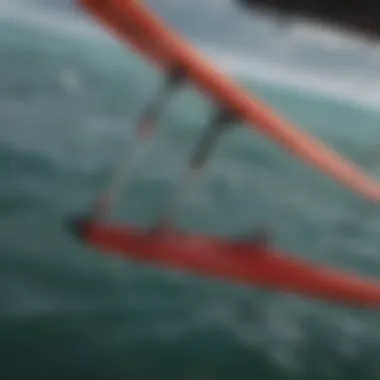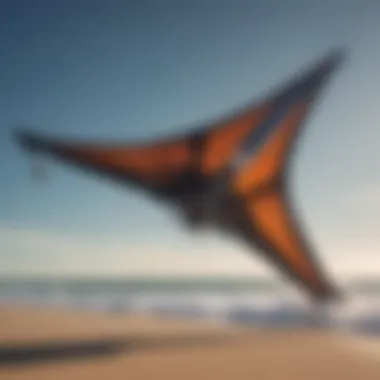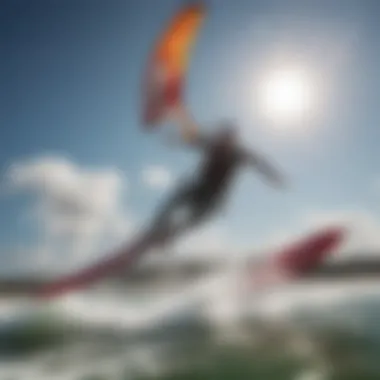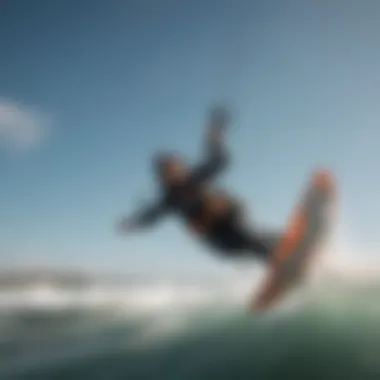Understanding Wing Stabilizers: Science & Impact in Kitesurfing


Intro
Kitesurfing is an exhilarating sport that merges techniques of surfing and paragliding. The equipment used is crucial to performance, with different components working in harmony. One such element which has gained traction in recent times is the wing stabilizer. Understanding its mechanics and significance can elevate both the performance and safety in kitesurfing.
Wing stabilizers primarily serve to enhance stability during flight, which is vital in various riding conditions. They aid in maintaining control over the kite, even in unpredictable winds. The science behind these devices draws from principles of aerodynamics and fluid dynamics, thus presenting a rich landscape for discussion.
Next, I will elaborate on the types of stabilizers, their impact on kitesurfing dynamics, and deeper insights into how integration of such devices could affect your experience. This will touch on multiple aspects including design, types, performance enhancement, and safety implications—the reason they are essential accessories in kitesurfing gear.
Equipment Reviews
Kitesurfing demands equipment that can withstand intense environments. Understanding various components, specially the wing stabilizers and other associated apparatus, can significantly influence experience.
Kites
Exploring the latest kite models offers a window into the strides of technology in the sport. Key features to examine include:
- Kite shapes: Different shapes like delta, C-shape, and hybrids cater to distinct riding styles.
- Sizes: Size variations impact power and maneuverability, affecting decisions based on wind conditions.
- Materials: The fabric technology employed can greatly influence durability and performance.
- Brands: Recognizable names in the market include Naish, Cabrinha, and F-One, each presenting unique innovations, particularly in integrating stabilizers.
Particular attention should be given to kites incorporating advanced wing stabilizer mechanisms. These models allow for better control, making them preferred choices among serious athletes.
Boards
Kiteboarding boards play an essential role in the kitesurfing experience. Notable types are:
- Twintips: Versatile boards allowing easy stance switching for freestyle tricks.
- Directional: Specialized for surf-style riding, enhancing performance in waves.
Both classes find ongoing refinement in design and construction, focusing on suitable riding styles. Choices meet various parameters, such as rider skill level and environmental conditions. The choice of board works towards balancing stability, as influenced by wing stabilizers, enhancing fluid riding on water.
Accessories
Kitesurfing embodies complexity that extends beyond the kite and board. Essential accessories include:
- Harnesses: Crucial for the transference of forces from the kite to the body.
- Lines: The control lines must be robust, facilitating reliable connection with the kite.
- Pumps: Efficient pumps streamline your pre-ride process, reflecting both quality and usability.
- Safety gear: Ultimately protects against various mishaps.
Understanding these accessories' significance aids enhanced performance and ensures the kitesurfing adventure is as safe as possible.
In the following sections, I will discuss the travel hotspots optimal for kitesurfing, the techniques to hone your skills, and elaborate guidelines on ensuring safety in and out of the water.
Understanding Wing Stabilizers
Wing stabilizers are vital components in the realm of kitesurfing, where precision, performance, and safety intersect. Without a deep understanding of these devices, kitesurfers may not fully appreciate how they enhance the overall kitesurfing experience. The importance of wing stabilizers lies in their ability to provide enhanced control during variable conditions, stabilizing the craft for better maneuverability and reducing the risk of accidents. Their design and functionality fundamentally influence the kite's interaction with wind, making it crucial for both novice and experienced kitesurfers to comprehend their relevance.
Definition and Purpose
Wing stabilizers serve a clear purpose in kitesurfing: they enhance stability and control while in motion. By reducing unwanted lateral movement, they allow riders to maintain a steady course, especially in challenging weather conditions. Stabilizers work by restructuring airflow around the kite, influencing lift and drag orientation. This contributes not only to the rider's safety but also to the efficiency of each ride.
Understanding the definition of wing stabilizers is essential for appreciating their place in the design of kites. The core purpose is to ensure that the. kite responds predictably during complicated maneuvers. Therefore, knowing this, we can conclude that wing stabilizers are crucial for trajectory control.
Mechanics of Stability
The mechanics underlying wing stabilization primarily involve the principles of aerodynamics and fluid dynamics. The air flowing over and under the kite plays a significant role in determining how stable it remains during flight. By ensuring that the center of lift is balanced relative to the center of mass, wing stabilizers create a more favorable flying condition.
Research shows that the proper adjustment of the kite's design, in harmony with the stabilizers, can reduce turbulence. Lower turbulence results in less chaotic air movement, which promotes a smoother ride. key takeaway is that well-integrated wing stabilizers optimize flight characteristics, contributing to an overall productive kitesurfing experience. This mechanic not only enhances enjoyment but also enforces the strategic aspect of the sport, making it appealing to participants seeking advanced technical understanding.
"Understanding the mechanics of wing pabl.@sers significantly enhances rider performance and ensures a more enjoyable kitesurfing experience."
Ultimately, knowing how wing stabilizers function in kitesurfing not only protects the individual rider but elevates the entire community through the raising of technical standards among participants.
Types of Wing Stabilizers
Understanding the types of wing stabilizers plays a crucial role in fully grasping their impact on kitesurfing performance. Each type of stabilizer offers distinct advantages, adaptations to varied conditions, and a certain level of responsiveness, making it essential for any kitesurfer to know how they function.


Active Stabilizers
Active stabilizers are devices that use technology to enhance stability in real-time. These systems actively adjust wing configurations or alter the angles based on current conditions during flight. This dynamic reaction allows kites to respond better to factors such as wind changes or sudden movements. Forces experienced while kitesurfing can fluctuate frequently, and having active stabilizers not only boosts stability but also supports safety. Kites equipped with active stabilizers tend to have a higher responsiveness to rider commands, which encourages more aggressive riding styles, suitable for experienced kitesurfers.
Passive Stabilizers
Passive stabilizers rely on aerodynamic design rather than active mechanical engagement. These stabilizers are integrated into the wing's structure, optimizing the airflow to enhance stability without requiring additional systems. A well-designed wing can create a balance between lift and drag. The stability provided by passive systems is ideal for smoother sailing, especially for those who prioritize focused control. Kites utilizing passive stabilizers often lend themselves to a more nostalgic riding experience. They have these inherent qualities that prevail in various wind conditions. This requires less adjustment and works better across a broader range of users.
Adaptive Stabilizers
Adaptive stabilizers are innovative solutions that recalibrate themselves based on environmental variables. Similar to active stabilizers, but distinctive in their passive adjustments. Their design focuses on estimating the kiting environment's changing circumstances, thus modifying stabilizer shapes or surfaces when needed. They are becoming increasingly sought after amongst kitesurfers who appreciate technology and seem to provide maximum versatility. For many riders, the freedom these stabilizer types foster encourages experimentation within their riding profiles, setting up a lively topic for inspiration.
"Understanding the type of stabilizer can make a significant difference in a kitesurfer's overall experience and performance on the water."
Design Aspects of Wing Stabilizers
Design plays a crucial role in the effectiveness and performance of wing stabilizers in kitesurfing. Various elements interplay to determine how well these stabilizers function in real-world conditions. From material choices to aerodynamic profiles and structural integrity, each aspect contributes significantly to the overall stability and safety of the kites. A strong understanding of these design elements can help both manufacturers and kitesurfers enhance their craft and experience.
Material Selection
When it comes to wing stabilizers, the choice of material is imperative. Kitesurfing demands durability given the exposure to harsh elements like sunlight, saltwater, and extreme winds. Common materials include polyethylene, carbon fiber, and dacron. It’s necessary to strike a balance between weight, strength, and flexibility when selecting the appropriate materials.
- Polyethylene is lightweight. This is useful for smaller wings but generally less durable under stress.
- Carbon fiber offers superb strength-to-weight ratio. It attracts serious kitesurfers but may inflate the cost.
- Dacron, though heavier, ensures durability. This makes it favored in the production of larger kites.
Ultimately, the choice of material affects the dynamics of performance. Materials with good flexural properties ensure effective energy transfer during flight, making performance flows and reductions in drag more effective. Moreover, the right material extends the collar’s lifespan while maintaining performance integrity over prolonged exposure.
Aerodynamic Considerations
Aerodynamics significantly impacts how stabilizers enhance performance. The design must minimize drag while optimizing lift. Air must flow seamlessly over the surface, with careful consideration to the wing's curvature and angle of incidence.
A few critical components to keep in mind are:
- Wing Shape: Certain wing shapes offer distinct stability characteristics, creating efficient airflow.
- Profile Thickness: Thicker profiles generally increase lift but may introduce additional drag.
- Leading Edge Configuration: Modifications here can reduce turbulence and enhance laminar flow, creating a smooth ride even in choppy conditions.
The aerodynamic design fosters performance and contributes to energy efficiency. When wind interacts favorably with the stabilizer’s design, it leads to smoother sailing experience. Ultimately, kitesurfers benefit from more controlled flight and increased speed, essential for any ambitious athlete.
Structural Integrity
Structural integrity refers to the strength and durability of the stabilizer's design under pressure. Wing stabilizers must withstand turbulent conditions and abrupt maneuvers encountered in kitesurfing. It is paramount that stability is not compromised as this can lead to accidents.
Key factors here include:
- Reinforcements: Adding reinforcements in strategic locations enhances strength without unnecessarily increasing weight.
- Testing for Stress Limits: Evaluating the wing’s ability to bear varying forces ensures safety.
- Quality Assurance: Regular testing before market launch becomes essential. Designs that boast high-quality builds perform outstandingly even under adverse conditions, preserving safety and performance.
A cohesive understanding of structural integrity ensures that a wing retains its critical performance characteristics throughout its lifecycle.
Understanding the design aspects is central to creating progressive and high-performance wing stabilizers. Effective decisions in materials, aerodynamics, and structural integrity ensure use in diverse and challenging conditions.
Functionality of Wing Stabilizers
Wing stabilizers play a critical role in the performance and safety of kitesurfing. They enhance the stability and effectiveness of the kite by ensuring optimal lift and control during maneuvers. Understanding their functionality is imperative for both skilled athletes and beginners alike. The significance stems from ensuring safety and improving the overall riding experience.
Influence on Lift and Drag
The physics behind lift and drag directly link to the shape and design of wing stabilizers. A well-functioning stabilizer can boost lift while minimizing drag, allowing for a smoother ride. This dynamic allows riders to experience better acceleration, especially in varying wind conditions. When kitesurfers adjust their speed, the stabilizers help maintain the balance and control needed to glide effortlessly through the water.
The balance between lift and drag is delicate. Optimized wing stabilizers help in maintaining that equilibrium. Excessive drag can hinder speed, particularly during fast turns or jumps. Thus, employing effective stabilizers improves overall efficiency by balancing the aerodynamic forces at play.
Enhancing Maneuverability
Maneuverability refers to the ability of the kite to turn and adapt quickly in response to the rider’s inputs. Wing stabilizers enhance this aspect by acting as control surfaces. They provide the necessary aerodynamic responses to shifts in the rider's weight and wind pressure. Consequently, riders experience tighter turns and quicker reactions. This agility is crucial for performing tricks, riding in aggressive winds, or just enjoying a leisurely day on the water.


Moreover, the position and angle of wing stabilizers affect handling characteristics. More advanced systems adjust in real-time to maintain optimal control, especially in challenging conditions. This added control translates directly into rider confidence, allowing them to push their limits.
Safety Features
Safety is paramount in kitesurfing. Wing stabilizers incorporate features that promote stability during unexpected shifts in wind conditions. By counteracting jolts that could cause the kite to tip or spin uncontrollably, stabilizers becoome a crucial line of defense.
Here are some key safety features comprised in these designs:
- Automatic recovery systems: Fusion of safety techniques that contribute to maintaining kite stability during excessive speeds or turbulent air.
- Redundant control mechanisms: They ensure riders maintain command even if external variables disturb the kite’s normal flight pattern.
- Predictive responses: Stabilizers that can adapt based on preceding flight behavior are commendable, aligning with the principles of modern kitesurfing technology.
Impact on Performance
The impact of wing stabilizers on performance in kitesurfing is an aspect often underestimated. Stabilizers are not merely accessories but integral components that define how a kite behaves in various conditions. The benefits are multifaceted, focusing primarily on speed, stability, and the learning journey of new kitesurfers.
Speed and Agility
One of the pronounced contributions of wing stabilizers is the enhancement of speed and agility. Kites fitted with advanced stabilizers exhibit lower drag coefficients. This aspect allows the kites to slice through wind with increased efficacy, fostering a better harnessing of the wind power. The responsiveness improves. Thus riders can perform quick turns and alterations with great ease, enabling a more dynamic riding experience.
Additional benefits come into play during competition settings. Riders can gain critical seconds by optimizing their pulls and transitions. Factors such as lift created by these devices play an essential role. Kites gain altitude faster, allowing for tricks or jumps that would otherwise require more time and effort. This increased performance factor is essential not only for competitions but also for recreational enthusiasts.
Stability during Flight
Flight stability is paramount in kitesurfing, chiefly contributable to wing stabilizers. A well-designed stabilizer maintains the kite's trajectory against sudden wind changes, thus providing reliability during flight. It reduces the occurrences of uncontrollable spins and nosedives. Both of these are safety concerns that could otherwise lead to injuries or equipment damage.
Stability further enhances rider confidence. When the kite maintains a steady position, a kitesurfer is more inclined to engage with progressive hooks or jumps. This aspect fosters a smoother navigation experience.
Moreover, advanced stabilizers aid amateur friendships with the learning process. With the right stabilization in place, amateurs can practice various maneuvers with lesser chances of accidents. This accessibility revitalizes the sport. Such a factor can't be understated for both safety and enjoyment.
Learning Curve for Beginners
The impact of wing stabilizers extends into the learning curve for kitesurf novices. Newbies often struggle with acceleration and control. Stabilizers provide assistance in such foundational stages, creating an easier environment to learn essential skills. Fly-in updraft avoidance, quick directional shifts, and balancing become less daunting tasks, as stabilizers counteract irregular winds.
Their inclination to promote stability on takeoff and landing makes them indispensable for newcomers. In this stage, learners can concentrate more on mastering turns and taking-off technique. Thus, the frustration from not grasping these fundamentals is considerably reduced.
With enhanced stability routines offered by proper wing stabilizers, more individuals are likely to continue in to sport and lessen drop-off rates attributable to initial struggles.
Proper wing stabilizers foster an atmosphere where both speed and safety can coexist in the sport of kitesurfing.
In summary, the investigation into the impact of wing stabilizers goes beyond appearances. They represent essential enhancements to performance in multiple dimensions, from speed to learning avenues for beginners. Delving deeper into such mechanics will only serve to refine the sport further, paving the way for comprehensive expertise in kitesurfing.
Technological Advancements in Wing Stabilizers
Technological advancements are crucial components in the evolution of wing stabilizers within kitesurfing. These improvements enhance performance, increase reliability, and improve safety for users. To elaborate, let us analyze two significant areas: smart stabilization systems and integration with electronic devices.
Smart Stabilization Systems
Smart stabilization systems represent a modern leap in wing design and functionality. These systems utilize a combination of sensors, algorithms, and data analysis to adjust the wing’s position and orientation during flight.
The vital benefits of smart stabilization systems include:
- Real-time adjustments: Immediate responses to changing wind conditions maximize stability and control.
- Improved performance: Personalized flight characteristics optimize lift-to-drag ratios.
- Enhanced safety: Systems reduce the risk of accidents by automatically correcting potential imbalances.
Moreover, the use of advanced materials enables these systems to be both lightweight and durable. As technology progresses, these systems become even more compact and efficient. Kite sports enthusiasts can expect to see continual refinement in this area.
“Smart stabilization technologies open a new chapter for kitesurfing, making it more accessible and enjoyable.”
Integration with Electronic Devices
The integration of wing stabilizers with electronic devices marks another step forward in kitesurf innovation. Devices like smartphones, smartwatches, and remote controls can provide vital feedback and controls for users.
Potential benefits include:


- Enhanced data tracking: Users can analyze flight patterns and performance metrics, allowing for targeted improvements.
- Adaptive control systems: Riders can dynamically adjust wing characteristics through simple interfaces—this puts customization within easy reach.
- Safety alerts: Real-time notifications can warn of dangerous wind shifts or other environmental concerns, highlighting the importance of continual awareness.
As these technologies evolve, the potential for creating highly interactive and personalized kitesurfing experiences grows substantially. Electronic integration not only personalizes kitesurfing but ensures that safety and performance can harmoniously coexist, making the sport even more appealing.
Through these technological advancements, the landscape of kitesurfing is set to transform, granting riders more freedom and excitement on the water.
Customization of Wing Stabilizers
Customization of wing stabilizers plays a vital role in the kitesurfing experience. By adjusting vital components according to individual preferences, users can enhance performance and fit their specific needs. It is important for kitesurfers to understand how customization options can affect both stability and maneuverability, paving the way for a more responsive and exhilarating ride.
Personalizing Performance
Personalizing performance involves modifying key aspects of wing stabilizers, such as size, shape, and angle of incidence. Tailoring these features can significantly impact how a kite behaves in various wind conditions. For instance, a larger stabilizer may provide increased lift, which can be beneficial in lighter winds. However, this modification requires nuances, as larger stabilizers can also cause excess drag, hindering agility.
Kitesurfers often adjust settings to strike a balance between stability and speed. Modifications also accommodate different styles of riding, like freestyle or wavekiting, leading to individualized performance. Also, experienced riders may swap out parts based on their level of skill and desired challenge. The key is finding the right blend to tailor their machines to respond exactly how they want them to—creating that seamless interaction between rider and equipment.
User Preferences and Compatibility
User preferences are immensely important when it comes to wing stabilizers. Each rider has unique writing styles and personal preferences which should easily integrate with their gear. Manufacturers understand this diversity. Therefore, they often offer a range of aftermarket options tailored to different profiles of kitesurfers.
It is crucial to check compatibility when selecting custom options. Not all parts are interchangeable across various brands or models. Users should closely examine specifications before proceeding with customization. Some products provide modular attachments that allow for various settings but always consult limitations in performance and design. Choosing the right components can bolster not only riding comfort but also overall safety while maximizing each session's potential on the water.
In summary, the customization of wing stabilizers is a key element for optimization in kitesurfing. The combined effect of considering performance factors and individual preferences enhances overall enjoyment and safety in this thrilling sport.
Comparative Analysis of Wing Stabilizers
The comparative analysis of wing stabilizers serves as a crucial component in understanding the correct application and effectiveness of these devices within the context of kitesurfing. Learning the strengths and weaknesses of various stabilizers can help both beginners and experts make informed choices, enhancing their overall kitesurfing experience. In a sport where performance, safety, and adaptability matter significantly, understanding which type of stabilizer works best under given conditions is vital.
Effectiveness Assessment
Assessing the effectiveness of wing stabilizers involves examining their ability to perform in various conditions. Users seek reliable stabilizers that respond well to different wind and wave situations. For this purpose, key performance metrics include speed enhancement, maneuverability, and stability. Research has shown that stabilizers like the North Reach optimally perform during high winds, demonstrating increased lift with lesser drag. On the other hand, stabilizers such as the Slingshot Banga offer great reliability in variable conditions, assuring consistent performance.
Factors influencing their effectiveness can include:
- Design: Aerodynamic shape can significantly determine stability and versatility.
- Material: Lightweight yet durable materials can ensure that impact does not hinder performance.
- User experience level: Beginners may prefer more stable and forgiving options while experts flock to high-performance stabilizers that allow for greater control and dynamics.
The right assessment combined with targeted testing often predicts a stabilizer's potential during different kiting activities.
User Reviews and Feedback
User reviews provide essential insights into the performance of various wing stabilizers in real-world conditions. These experiential accounts ensure that potential buyers make knowledgeable decisions, particularly for a niche sport like kitesurfing. Feedback often highlights areas such as performance strengths, responsiveness, and reliability during actual use. Brands like Duotone and Cabrinha have frequent discussions in forums regarding their stabilizers' impact on user experience.
When analyzing user feedback, readers may want to look for common themes in reviews:
- Stability under different conditions.
- The ability to enhance maneuverability without sacrificing safety.
- Compatibility with other gear components.
Taking the time to explore relevant platforms, such as Reddit or kitesurfing user groups on Facebook, can yield first-hand accounts attesting to or challenging current knowledge of wing stabilizers.
End
Wing stabilizers play a crucial role in kitesurfing, enhancing both the performance and safety of the sport. Their functional design enables a unique balance of stability and maneuverability. Being informed about wing stabilizers benefits all kitesurfers, regardless of experience.
Future of Wing Stabilizers in Kitesurfing
Looking ahead, the future of wing stabilizers is promising. With continued advancements in material science and aerodynamics, we may see lighter and more responsive designs. Companies are likely to integrate more sophisticated technology, such as sensors and real-time data acquisition, which can improve the stabilizers' effectiveness.
Moreover, environmental sustainability will likely influence the direction of design. Biodegradable materials or recycled composites could become common in manufacturing wing stabilizers, aligning with broader ecological goals.
The focus will likely shift to developing stabilizers that not only cater to performance but also boast eco-friendly attributes. Future stabilizers may adapt better to varying water and wind conditions, allowing greater versatility and safety.
Final Thoughts on Safety and Performance
Safety remains paramount for kitesurfers of all levels. Stabilizers effectively reduce accidents caused by loss of control, making the sport more accessible. Wearing a leash or safety gear is still necessary, even with stabilizers.
Performance-wise, these devices markedly improve glide efficiency. Increased lift reduces fatigue, allowing longer sessions on the water. Nevertheless, it is essential that kitesurfers understand their equipment's design characteristics.
As the technology develops, kitesurfers should prioritize education on equipment usage. This understanding enables users to maximize the benefits of stabilizers, thereby fine-tuning their performance skills and enhancing overall enjoyment in the sport.
In summary, the ongoing development of wing stabilizers signifies a leap towards a safer and more engaging kitesurfing experience.







